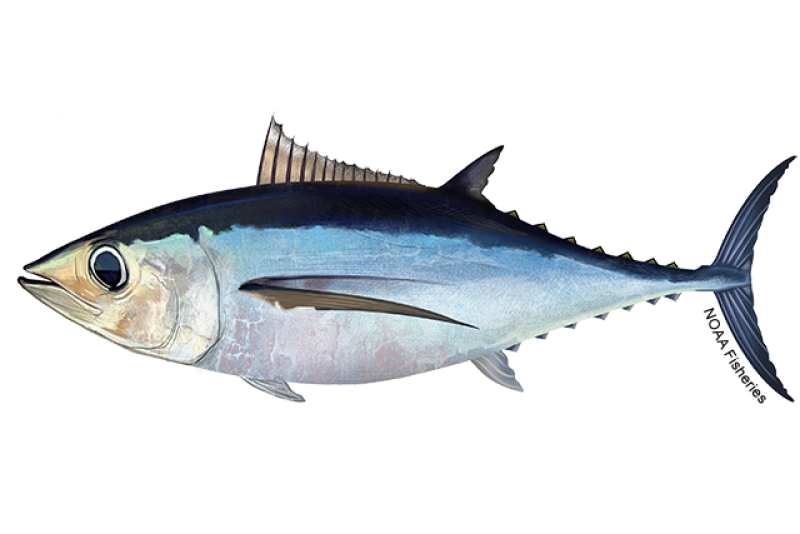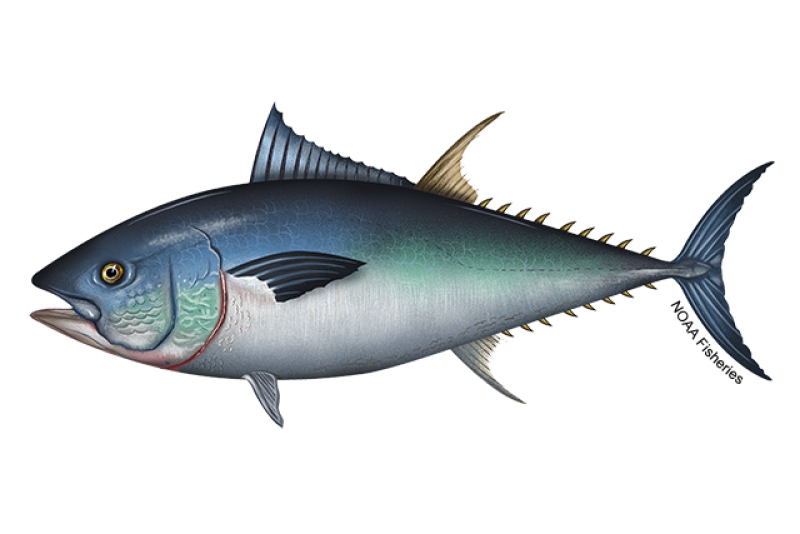 Bigeye tuna fish. Credit: NOAA Fisheries/Allen Shimada
Bigeye tuna fish. Credit: NOAA Fisheries/Allen Shimada
Bigeye tuna fish. Credit: NOAA Fisheries/Allen Shimada
About the Species
 Bigeye tuna fish. Credit: NOAA Fisheries/Allen Shimada
Bigeye tuna fish. Credit: NOAA Fisheries/Allen Shimada
Bigeye tuna fish. Credit: NOAA Fisheries/Allen Shimada
U.S. wild-caught Pacific bigeye tuna is a smart seafood choice because it is sustainably managed and responsibly harvested under U.S. regulations.

Population
The stocks are not overfished.

Fishing Rate
Not subject to overfishing.

Habitat Impact
Fishing gear used to catch bigeye tuna rarely contacts the seafloor so habitat impacts are minimal.

Bycatch
Regulations are in place to minimize bycatch.
Population Status
- There are two stocks of Pacific bigeye tuna: the Western and Central Pacific stock and the Eastern Pacific stock. According to the most recent stock assessments:
- The Western and Central Pacific stock is not overfished and not subject to overfishing (2023 stock assessment). Summary stock assessment information can be found on Stock SMART.
- The Eastern Pacific stock is not overfished and is not subject to overfishing (2024 stock assessment). Summary stock assessment information can be found on Stock SMART.
- Since hitting a low in 2004, the Eastern Pacific population has been increasing in abundance and is now above its target population level. The increase is partly due to international tuna conservation measures, which established time/area closures for the purse seine fleets and instituted catch quotas in the longline fleets.
Appearance
- Bigeye tuna are dark metallic blue on the back and upper sides and white on the lower sides and belly.
- The first fin on their back is deep yellow, the second dorsal and anal fins are pale yellow, and the finlets are bright yellow with black edges.
- Bigeye and yellowfin tuna look fairly similar. In fact, it’s hard to distinguish the two species without experience.
- Among other characteristics, the bigeye’s eyes are larger than the yellowfin’s and their finlets have black edges.
Biology
- Bigeye tuna grow fast and can reach about 6.5 feet in length.
- They live 7 to 8 years and are able to reproduce when they are 3 years old.
- Bigeye tuna spawn throughout the year in tropical waters and seasonally in cooler waters.
- They’re able to spawn almost daily, releasing millions of eggs each time.
- Eggs are found in the top layer of the ocean, buoyed at the surface by a single oil droplet until they hatch.
- Bigeye tuna feed near the top of the food chain, preying on fish, crustaceans, and squid.
- They are prey for many top predators, including larger tunas and billfish.
Where They Live
Range
- Bigeye tuna are found throughout the Pacific, Atlantic, and Indian Oceans, including the waters around the U.S. Pacific Islands and off southern California.
Habitat
- Bigeye tuna are highly migratory and travel long distances throughout the ocean.
- They favor water temperatures between 55° and 84° F.
- Juvenile and small adult bigeye tuna school at the surface, sometimes with skipjack and juvenile yellowfin tunas.
- Schools of bigeye tuna may associate with floating objects or large, slow-moving marine animals such as whale sharks or manta rays.
- Bigeye tuna also group together near seamounts and submarine ridges.
Fishery Management
- NOAA Fisheries and the Pacific Fishery Management Council manage this fishery on the West Coast.
- Managed under the Fishery Management Plan for U.S. West Coast Fisheries for Highly Migratory Species:
- Fishermen are required to have permits and to record catch in logbooks.
- Gear restrictions and operational requirements are in place to minimize bycatch.
- Large purse seine vessels that fish for tuna in the eastern Pacific Ocean are required to have 100 percent observer coverage.
- All other commercial vessels based on the U.S. West Coast must carry an observer if requested by NOAA Fisheries.
- Longline fishing is prohibited within 200 miles of the U.S. West Coast.
- Annual training in safe handling and release techniques for protected species is required and all vessels must carry and use specific equipment for handling and releasing these animals.
- NOAA Fisheries and Western Pacific Fishery Management Council manage this fishery in the Pacific Islands.
- Managed under the Fishery Ecosystem Plan for the Pelagic Fisheries of the Western Pacific:
- Fishermen are required to have permits and to record catch in logbooks.
- Gear restrictions and operational requirements are in place to minimize bycatch and potential gear conflicts among different fisheries.
- A limit on the number of permits for Hawaii and American Samoa longline fisheries controls participation in the fishery.
- Longline fishing is prohibited in some areas to protect endangered Hawaiian monk seals, reduce conflicts between fishermen, and prevent localized stock depletion (when a large number of fish are removed from an area).
- These areas are enforced through the NOAA Fisheries vessel monitoring system program (longline boats must be equipped with a satellite transponder that provides real-time position updates and tracks vessel movements).
- Hawaii-based and American Samoa–based longline vessels must carry onboard observers when requested by NOAA Fisheries, in part to record interactions with sea turtles, seabirds, and marine mammals.
- Annual training in safe handling and release techniques for protected species is required and all vessels must carry and use specific equipment for handling and releasing these animals.
- Management of highly migratory species, like Pacific bigeye tuna, is complicated because the species migrate thousands of miles across international boundaries and are fished by many nations.
- Effective conservation and management of this resource requires international cooperation as well as strong domestic management.
- Two international organizations, the Inter-American Tropical Tuna Commission (IATTC) and the Western and Central Pacific Fisheries Commission (WCPFC), manage this fishery internationally. Working with the U.S. Department of State, NOAA Fisheries domestically implements the IATTC and WCPFC conservation and management measures.
- Under the South Pacific Tuna Treaty, U.S. purse seine vessels operating throughout the western and central Pacific Ocean must be registered and are monitored through logbooks, cannery landing receipts, national surveillance activities, observers, and port sampling.
- Purse seiners in the eastern Pacific Ocean also operate under the International Dolphin Conservation Program, a multilateral agreement aimed at reducing and minimizing bycatch of dolphins and undersize tuna.
- In 2000, the United States established the Dolphin-Safe Tuna Tracking and Verification Program to monitor the domestic production and importation of all frozen and processed tuna products nationwide and to authenticate any associated dolphin-safe claim.
Harvest
- Commercial fishery:
- The majority of U.S.-caught bigeye tuna comes from Hawaii, although a substantial amount is also harvested by U.S. purse seine vessels and landed in American Samoa or other countries for canning.
- In 2023, commercial landings of Pacific bigeye tuna totaled 14.5 million pounds and were valued at $71 million, according to the NOAA Fisheries commercial fishing landings database.
- Gear types, habitat impacts, and bycatch:
- Fishermen based in Hawaii, American Samoa, and the U.S. Pacific Islands target Pacific bigeye tuna with hook-and-line, pelagic longline, or troll fishing gear
- U.S. commercial purse seine fishermen in the western and central Pacific also harvest bigeye tuna.
- The U.S. coastal purse seine fleet operating in the eastern Pacific Ocean typically fish off California for small pelagic species such as sardine and anchovy and sometimes catch bigeye tuna when warm water from the south brings bigeye tuna within their range.
- Fishing gear used to catch Pacific bigeye tuna rarely contacts the seafloor so habitat impacts are minimal.
- Restrictions on the type of fishing gear that can be used, and prohibitions on fishing in certain areas, minimize impacts on protected species.
- Interactions with protected species such as sea turtles, marine mammals, and seabirds in these fisheries are rare and survival rates are estimated to be high for all gear types.
- Longline fishermen are trained in safe handling and release techniques for sea turtles, seabirds, and marine mammals, and they carry and use specific equipment for handling and releasing these animals.
- Scientists and managers continue to monitor bycatch in these fisheries through logbooks and fishery observer programs.
- Management measures are in place to minimize bycatch of juvenile Pacific bigeye tuna.
- Recreational fishery:
- Off California, anglers must be licensed and daily bag limits are in place. Recreational charter boats must keep logbooks of their catch.
- There are no federal regulations for recreational fishing off Hawaii and U.S. Pacific Island territories, but local rules may apply.
Scientific Classification
- Bigeye tuna are found throughout the Pacific, Atlantic, and Indian Oceans, including the waters around the U.S. Pacific Islands and off southern California.
- Bigeye tuna are highly migratory and travel long distances throughout the ocean.
- They favor water temperatures between 55° and 84° F.
- Juvenile and small adult bigeye tuna school at the surface, sometimes with skipjack and juvenile yellowfin tunas.
- Schools of bigeye tuna may associate with floating objects or large, slow-moving marine animals such as whale sharks or manta rays.
- Bigeye tuna also group together near seamounts and submarine ridges.
Fishery Management
- NOAA Fisheries and the Pacific Fishery Management Council manage this fishery on the West Coast.
- Managed under the Fishery Management Plan for U.S. West Coast Fisheries for Highly Migratory Species:
- Fishermen are required to have permits and to record catch in logbooks.
- Gear restrictions and operational requirements are in place to minimize bycatch.
- Large purse seine vessels that fish for tuna in the eastern Pacific Ocean are required to have 100 percent observer coverage.
- All other commercial vessels based on the U.S. West Coast must carry an observer if requested by NOAA Fisheries.
- Longline fishing is prohibited within 200 miles of the U.S. West Coast.
- Annual training in safe handling and release techniques for protected species is required and all vessels must carry and use specific equipment for handling and releasing these animals.
- NOAA Fisheries and Western Pacific Fishery Management Council manage this fishery in the Pacific Islands.
- Managed under the Fishery Ecosystem Plan for the Pelagic Fisheries of the Western Pacific:
- Fishermen are required to have permits and to record catch in logbooks.
- Gear restrictions and operational requirements are in place to minimize bycatch and potential gear conflicts among different fisheries.
- A limit on the number of permits for Hawaii and American Samoa longline fisheries controls participation in the fishery.
- Longline fishing is prohibited in some areas to protect endangered Hawaiian monk seals, reduce conflicts between fishermen, and prevent localized stock depletion (when a large number of fish are removed from an area).
- These areas are enforced through the NOAA Fisheries vessel monitoring system program (longline boats must be equipped with a satellite transponder that provides real-time position updates and tracks vessel movements).
- Hawaii-based and American Samoa–based longline vessels must carry onboard observers when requested by NOAA Fisheries, in part to record interactions with sea turtles, seabirds, and marine mammals.
- Annual training in safe handling and release techniques for protected species is required and all vessels must carry and use specific equipment for handling and releasing these animals.
- Management of highly migratory species, like Pacific bigeye tuna, is complicated because the species migrate thousands of miles across international boundaries and are fished by many nations.
- Effective conservation and management of this resource requires international cooperation as well as strong domestic management.
- Two international organizations, the Inter-American Tropical Tuna Commission (IATTC) and the Western and Central Pacific Fisheries Commission (WCPFC), manage this fishery internationally. Working with the U.S. Department of State, NOAA Fisheries domestically implements the IATTC and WCPFC conservation and management measures.
- Under the South Pacific Tuna Treaty, U.S. purse seine vessels operating throughout the western and central Pacific Ocean must be registered and are monitored through logbooks, cannery landing receipts, national surveillance activities, observers, and port sampling.
- Purse seiners in the eastern Pacific Ocean also operate under the International Dolphin Conservation Program, a multilateral agreement aimed at reducing and minimizing bycatch of dolphins and undersize tuna.
- In 2000, the United States established the Dolphin-Safe Tuna Tracking and Verification Program to monitor the domestic production and importation of all frozen and processed tuna products nationwide and to authenticate any associated dolphin-safe claim.
Harvest
- Commercial fishery:
- The majority of U.S.-caught bigeye tuna comes from Hawaii, although a substantial amount is also harvested by U.S. purse seine vessels and landed in American Samoa or other countries for canning.
- In 2023, commercial landings of Pacific bigeye tuna totaled 14.5 million pounds and were valued at $71 million, according to the NOAA Fisheries commercial fishing landings database.
- Gear types, habitat impacts, and bycatch:
- Fishermen based in Hawaii, American Samoa, and the U.S. Pacific Islands target Pacific bigeye tuna with hook-and-line, pelagic longline, or troll fishing gear
- U.S. commercial purse seine fishermen in the western and central Pacific also harvest bigeye tuna.
- The U.S. coastal purse seine fleet operating in the eastern Pacific Ocean typically fish off California for small pelagic species such as sardine and anchovy and sometimes catch bigeye tuna when warm water from the south brings bigeye tuna within their range.
- Fishing gear used to catch Pacific bigeye tuna rarely contacts the seafloor so habitat impacts are minimal.
- Restrictions on the type of fishing gear that can be used, and prohibitions on fishing in certain areas, minimize impacts on protected species.
- Interactions with protected species such as sea turtles, marine mammals, and seabirds in these fisheries are rare and survival rates are estimated to be high for all gear types.
- Longline fishermen are trained in safe handling and release techniques for sea turtles, seabirds, and marine mammals, and they carry and use specific equipment for handling and releasing these animals.
- Scientists and managers continue to monitor bycatch in these fisheries through logbooks and fishery observer programs.
- Management measures are in place to minimize bycatch of juvenile Pacific bigeye tuna.
- Recreational fishery:
- Off California, anglers must be licensed and daily bag limits are in place. Recreational charter boats must keep logbooks of their catch.
- There are no federal regulations for recreational fishing off Hawaii and U.S. Pacific Island territories, but local rules may apply.
Scientific Classification
| Kingdom | Animalia | Phylum | Chordata | Class | Actinopterygii | Order | Scombriformes | Family | Scombridae | Genus | Thunnus | Species | obesus |
|---|
Last updated by NOAA Fisheries on 04/03/2025
Featured News
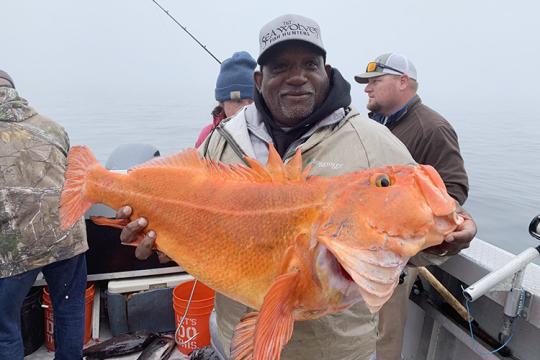
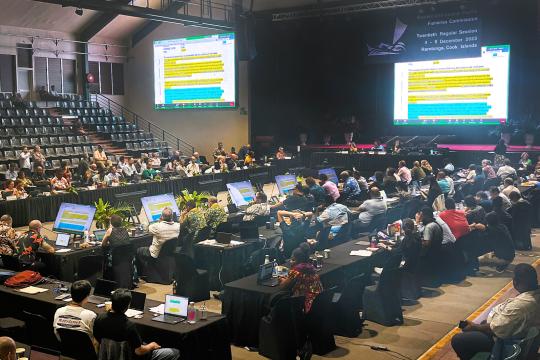 The 20th Annual Western and Central Pacific Fisheries Commission meeting at the Te Are Kariori (National Auditorium) in
Rarotonga, Cook Islands. Credit: NOAA Fisheries.
The 20th Annual Western and Central Pacific Fisheries Commission meeting at the Te Are Kariori (National Auditorium) in
Rarotonga, Cook Islands. Credit: NOAA Fisheries.
 A bidder checks the quality of tuna at the Honolulu Fish Auction. Credit: NOAA Fisheries
A bidder checks the quality of tuna at the Honolulu Fish Auction. Credit: NOAA Fisheries
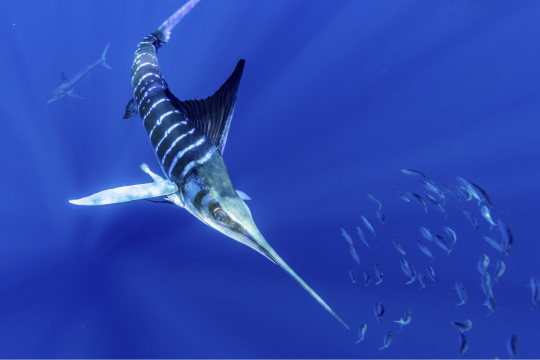 The striped marlin is a species of billfish that lives in the North Pacific. A new study co-led by NOAA scientists finds that marine predators, like the striped marlin, aggregate in anticyclonic, clockwise-rotating ocean eddies to feed. Credit: Pat Ford Photography.
The striped marlin is a species of billfish that lives in the North Pacific. A new study co-led by NOAA scientists finds that marine predators, like the striped marlin, aggregate in anticyclonic, clockwise-rotating ocean eddies to feed. Credit: Pat Ford Photography.
Seafood Facts

Is Pacific Bigeye Tuna Sustainable?
U.S. wild-caught Pacific bigeye tuna is a smart seafood choice because it is sustainably managed and responsibly harvested under U.S. regulations.
Availability
Year-round.
Source
U.S. wild-caught from Hawaii, California, U.S. Pacific Island territories, and the high seas.
Taste
Bigeye tuna has a mild, meaty flavor, with a higher fat content than yellowfinand is preferred by sashimi lovers.
Texture
Firm and moist, with large flakes.
Color
Bigeye tuna meat has a reddish-pink color.
Health Benefits
Bigeye tuna is low in saturated fat and sodium and is rich in niacin, vitamins B6 and B12, selenium, and phosphorous.
Nutrition Facts
Servings: 1; Serving Weight: 113 g; Calories: 130; Protein: 27 g; Total Fat: 2 g; Total Saturated Fatty Acids: 0.5 g; Carbohydrate: 0 g; Total Sugars: 0 g; Total Dietary Fiber: 0 g; Cholesterol: 45 mg; Selenium: 160% daily value; Sodium: 70 mgMore Information
Bigeye (Ahi) Tuna Recipes
Bigeye (ahi) tuna is prized for its sashimi and makes a delicious seared tuna steak. If you need cooking inspiration, browse these recipes for seared tuna, tuna ceviche, and more!

Last updated by NOAA Fisheries on 04/03/2025
Seafood News
 Celebrate Culinary Arts Month with a sustainable seafood recipe for every month of the year.
Celebrate Culinary Arts Month with a sustainable seafood recipe for every month of the year.
What Your Birth Month Says About Your Next Seafood Recipe
 Fresh-caught taʻape on ice. Credit: Conservation International Hawaiʻi.
Fresh-caught taʻape on ice. Credit: Conservation International Hawaiʻi.
Reducing Waste and Feeding Communities in Hawaiʻi with a Whole Fish Approach
 Chef Tyler Hadfield’s Curried Skate Wings with Tomato-Masala Chutney
Chef Tyler Hadfield’s Curried Skate Wings with Tomato-Masala Chutney
Ring In the New Year With These Crowd-Favorite Seafood Recipes
 NOAA Fisheries, in collaboration with Blue Ocean Mariculture, is conducting a multi-year pilot study to evaluate observational methods and tools for studying Hawaiian monk seal behavior. Courtesy of Blue Ocean Mariculture
NOAA Fisheries, in collaboration with Blue Ocean Mariculture, is conducting a multi-year pilot study to evaluate observational methods and tools for studying Hawaiian monk seal behavior. Courtesy of Blue Ocean Mariculture
AI Meets Aquaculture to Study Hawaiian Monk Seal Interactions With Net Pens
Documents
Evaluation of Electronic Monitoring Pre-implementation in the Hawaiʻi-based Longline Fisheries
The Pacific Islands Fisheries Science Center (PIFSC) is currently evaluating how to effectively use…
Vessel Level Annual Cost-Earnings Study of the Hawaii Offshore Handline Fishery and the Hawaii Small Boat Commercial Fishery, 2014
This study examines the economic performance of the offshore handline fishery and the Hawaii small…
Performance Assessment of Underwater Setting Chutes, Side Setting, and Blue-Dyed Bait to Minimize Seabird Mortality in Hawaiʻi Longline Tuna and Swordfish Fisheries
An assessment of underwater setting technologies.
Data & Maps
American Samoa Longline Logbook Reports 2023
Logbook summary reports for the 2023 calendar year.
American Samoa Longline Logbook Reports 2022
Logbook summary reports for the 2022 calendar year.
Hawaii and California Longline Logbook Reports 2022
Logbook summary reports for the 2022 calendar year.
Hawaii and California Longline Logbook Reports 2021
Logbook summary reports for the 2021 calendar year.
Research
Hedonic Price Model of Hawaiʻi ʻAhi Tuna (Thunnus obesus and Thunnus albacares) Market: Implications of Climate Change and Shark Depredation
Using a hedonic price model to estimate tuna price using fish characteristics, trip-specific…
Anticipating Fluctuations of Bigeye Tuna in the Pacific Ocean From Three-Dimensional Ocean Biogeochemistry
Results reveal the impact of variability of biogeochemical conditions in the ocean interior on the…
Seamount Effects on Micronekton at a Subtropical Central Pacific Seamount
Although seamounts are found globally and their ecological and economical importance is well known,…
Quantifying the Distribution of Swordfish (Xiphias Gladius) Density in the Hawaii-Based Longline Fishery
The multi-species VAST model was used to better understand swordfish and their response to…
Last updated by NOAA Fisheries on 04/03/2025


